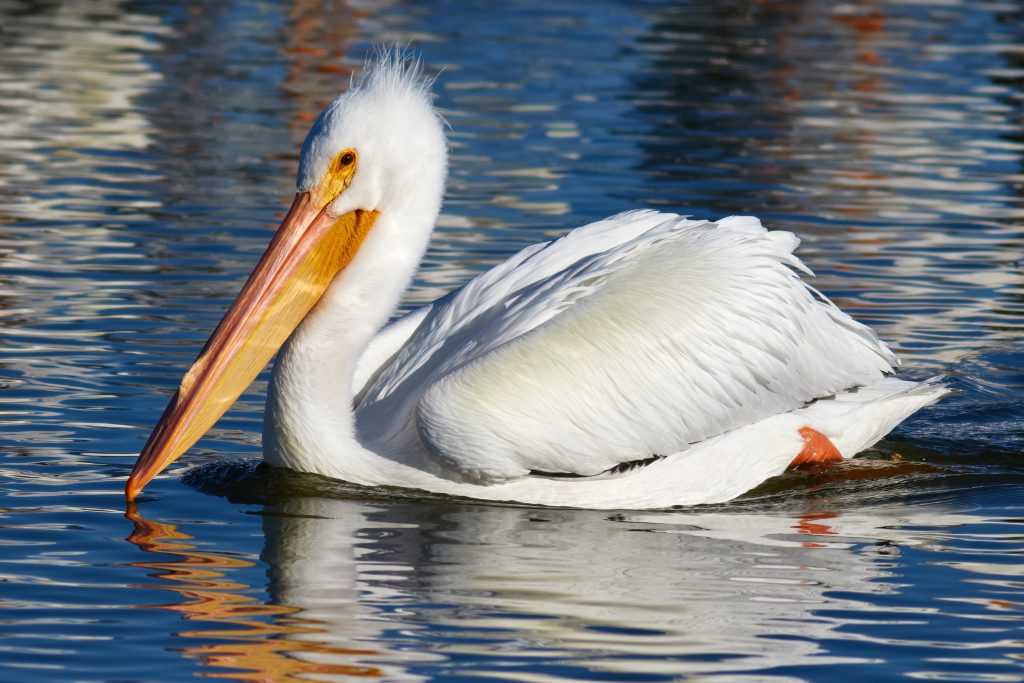Paul Hicks and Kathleen Snyder once again took an enthusiastic group of birders down to southwestern Washington in October. With cheerful, generous help from local experts Randy Hill and Bob Flores, the group spotted or heard 88 species at 11 sites.
Their top five sightings:

- Sandhill Crane: It’s a thrill just to hear their loud, resonant bugling as they glide effortlessly like a jumbo jet seemingly suspended in midair. Along Old Lower River Road we got close views of adults with juveniles.
- American White Pelican: We watched several of these huge, more-graceful-than-expected birds float by over Ridgefield NWR. A single bird returned for a curtain call.
- Wood Duck: Several gorgeous males posed nicely at Salmon Creek pond.
- Lesser Goldfinch: Everyone got prolonged views of these diminutive beauties at a Fruit Valley residence’s birdfeeders. This is one of the area’s sought-after specialty species.
- Northern Harrier: Perhaps up to 20 of these agile raptors were hunting the open expanses of the Woodland Bottoms — some quartering on the wing, others standing on the ground. Most were richly colored young birds.
Other highlights included:
1. Carty Unit of Ridgefield NWR
- Cranes and geese: Our first of many views of these flyover flocks.
- Varied Thrush: A surprising concentration of these handsome birds among the grand oak trees.
- White-breasted Nuthatch: Several of this specialty species were seen and heard among the oaks.
- Woodpeckers: All five woodpecker species were seen or heard.
- Red-shouldered Hawk: A brief glimpse of another of the area’s specialty species. Note: Red-shouldered Hawks are more typically found in California and may be expanding their range northward. They often have the distinct profile of bowed wings (rather than flat or up-tilted) when gliding. They like to hunt from a somewhat hidden perch in a tree, often near water.
2. Industrial water treatment pond
- Puddle & diving ducks: Including a large number of Ruddy Ducks and a few Canvasbacks.
- Peregrine Falcon: Randy spotted one flying overhead.
3. Vancouver Lake boat launch
We accessed the lakeshore from the south via a “back route” beyond Fruit Valley Park and the industrial water treatment facility.
- Yellow-rumped Warbler: Many at close range foraging in the willows along the shore; seen here and elsewhere.
4. Vancouver Lake Regional Park
- A variety of species coming to the birdseed scattered on the ground: sparrows, towhees, juncos, chickadees, both nuthatches; unfortunately no White-throated Sparrows. Also Brown Creeper, Yellow-rumped Warblers and Townsend’s Warbler in the trees.
- Ken sighted a possible “slate-colored” Junco, a scarce subspecies.
5. Erwin O. Rieger Memorial Highway / SR-501 Spur & pedestrian bridge
- Vaux’s Swift: One late-migrating bird overhead. (How in the world did Randy spot this guy?!?!)
- Missed: Black Phoebe: A no-show at the pedestrian bridge.
6. Old Lower River Road
- American Pipit: Large numbers feeding in the plowed field.
7. Vancouver’s Columbia River waterfront, including Marine Park
- Red-necked Grebe: Great find! A pair of rare “code 4” birds for Clark
County.
(see http://wabirder.com/county_map_pages.html, click on Clark County and checklist) - Several Western & Horned Grebes and Ruddy Ducks
- Assorted gulls: Among the gulls was a likely Western x Glaucous-winged hybrid with darker mantle and blackish wingtips.
8. Woodland Bottoms and Columbia River (Cowlitz County)
- Raptors galore!: Lots of N. Harriers and Red-tailed Hawks (most young birds), plus a Cooper’s Hawk.
- Egrets and herons: Several standing in the fields
- Misses: Ferruginous Hawk (super-rare “code 5” for Cowlitz County, recently reported), Rough-legged Hawk (a few will overwinter here), Black Phoebe (a scarce “code 4” flycatcher-type sometimes found near the pumphouses, bridges and farm structures along the slough and ditches; often detected by its incessant calling).







